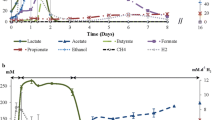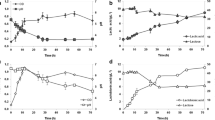Abstract
Proteolytic strains ofButyrivibrio alactacidigens, Butyrivibrio fibrisolvens, Selenomonas ruminantium, andStreptococcus bovis grew markedly better in medium containing casein as sole nitrogen source when they were inoculated in pairs rather than singly, when growth was poor or nil. The improved growth ofSelenomonas ruminantium with other species was a consequence of a faster rate of proteolysis by the mixed culture. The cooperativity withStreptococcus bovis was mediated by the extracellular activity ofSelenomonas ruminantium. Synergistic growth betweenBu. alactacidigens and other bacteria was not due to cooperativity between proteolytic activities but probably to nutritional interdependence between the species. Cooperative proteolysis also occurred in mixtures ofSelenomonas ruminantium andBacteroides ruminicola, a proteolytic isolate capable of growth on casein in monoculture.
Similar content being viewed by others
Literature Cited
Caldwell DR, Bryant MP (1966) Medium without rumen fluid for the non-selective enumeration and isolation of rumen bacteria. Appl Microbiol 14:794–801
Clark B, Holms WH (1976) Control of the sequential utilisation of glucose and fructose byEscherichia coli. J Gen Microbiol 95:191–201
Hazlewood GP, Edwards R (1981) Proteolytic activities of a rumen bacterium,Bacteroides ruminicola. J Gen Microbiol 125:11–15.
Hazlewood GP, Orpin CG, Greenwood Y, Black ME (1983) Isolation of proteolytic bacteria by use of selective medium containing leaf fraction 1 protein (ribulosebisphosphate carboxylase). Appl Environ Microbiol 45:1780–1784
Hobson PN (1969) Rumen bacteria. Methods Microbiol 3B:133–149
Hobson PN, Wallace RJ (1982) Microbial ecology and activities in the rumen. II: CRC Crit Rev Microbiol 9:253–320
Kopecny J, Wallace RJ (1982) Cellular location and some properties of proteolytic enzymes of rumen bacteria. Appl Environ Microbiol 43:1026–1033
Lesk EM, Blackburn TH (1971) Purification ofBacteroides amylophilus protease. J Bacteriol 106:394–402
Nugent JHA, Mangan JL (1981) Characteristics of the rumen proteolysis of Fraction 1 (18S) leaf protein from lucerne (Medicago sativa L.). Br J Nutr 46:39–59
Scott HW, Dehority BA (1965) Vitamin requirements of several cellulolytic rumen bacteria. J Bacteriol 89:1169–1175
Wallace RJ (1983) Hydrolysis of14C-labelled proteins by rumen micro-organisms and by proteolytic enzymes prepared from rumen bacteria. Br J Nutr 50:345–355
Wallace RJ (1985) Adsorption of soluble proteins to rumen bacteria and the role of adsorption in proteolysis. Br J Nutr 53:399–408
Wallace RJ, Brammall ML (1985) The role of different species of bacteria in the hydrolysis of protein in the rumen. J Gen Microbiol 131:821–832.
Wallace RJ, Kopecny J (1983) Breakdown of diazotised proteins and synthetic substrates by rumen bacterial proteases. Appl Environ Microbiol 45:212–217
Wolin MJ, Miller TL (1983) Interactions of microbial populations in cellulose fermentation. Fed Proc 42:109–113
Author information
Authors and Affiliations
Rights and permissions
About this article
Cite this article
Wallace, R.J. Synergism between different species of proteolytic rumen bacteria. Current Microbiology 12, 59–63 (1985). https://doi.org/10.1007/BF01567392
Issue Date:
DOI: https://doi.org/10.1007/BF01567392




